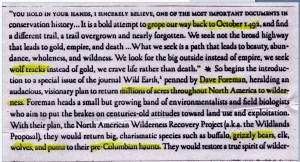Sent: Monday, November 14, 2011 9:04 AM
To:
Subject: From the Office of Senator Cantwell
Dear Mr. Coulson,
Thank you for contacting me about removal of the Elwha and Glines Canyon Dams on the Olympic Peninsula. I appreciate hearing from you on this important matter and sincerely regret the delayed response.
As you know, the lower course of the Elwha River currently has two dams – the Elwha, completed in 1914, and the Glines Canyon, completed in 1927. Though they have a combined average generation output of 18.7 megawatts, neither project has fish passage facilities. The construction of the Elwha Dam blocked access to approximately 93 percent of the historical anadromous fish habitat on the Elwha River. Before the dams were built, the river produced an estimated 380,000 salmon and trout, while current, largely hatchery-based, fish runs in the Elwha River average around 10,000 annually.
In the 1970s and 80s, the licensing of the Elwha Dam and re-licensing of the Glines Canyon Dam through the Federal Power Commission (now the Federal Energy Regulatory Commission) was subject to significant controversy and extensive delay due to a variety of factors, including the policy implications of licensing a project within a national park (Olympic National Park), conflicting federal, state, and tribal resource goals, and legal challenges from the environmental community.
As a result of the ongoing conflicts, on October 24, 1992, Congress passed the Elwha River Ecosystem and Fisheries Restoration Act (P.L. 102-495). This bill was a negotiated solution to avoid litigation, protect jobs at the paper mill that uses power generated by the dams, generate economic growth through fishing, tourism and recreation in the area, restore fisheries and the river ecosystem, and meet federal tribal trust responsibilities.
The Act directed the Secretary of the Interior to develop a report for Congress assessing alternatives that would lead to ecosystem restoration and fisheries recovery. A final “programmatic” Environmental Impact Statement (EIS) released in June 1995 recommended removal of both dams. An additional “implementation” EIS released in November 1996 recommended using natural erosion to dispose of accumulated sediment behind the dams.
In 2005, a final record of decision was issued to move forward with the restoration project, which includes removal of both dams, addressing erosion and sediment concerns, building new water and sewage treatment facilities, and other steps to mitigate economic and environmental impacts. For more information on this project, I’d encourage you to visit http://www.nps.gov/olym/naturescience/elwha-ecosystem-restoration.htm.
The Elwha River Restoration Project began on September 17, 2011, and will cost an estimated $351 million over three years. The first of its kind and scale in our country, this project has the potential to be a game-changer for salmon on the Olympic Peninsula. Once the dams are removed, migratory salmon will, for the first time in nearly 100 years, have full access to spawn the entire length of the Elwha River. The restored river will result in an estimated 2,000 local jobs related to the fishing industry. I am satisfied that decisions surrounding the Elwha River Restoration Project have been grounded in science, and that measures have been taken at every step of the way to ensure salmon are protected and that the dam removal is safe for communities downriver.
Thank you again for contacting me to share your thoughts on this matter, and I appreciate the opportunity to learn your views on the Elwha River dam removal. You may also be interested in signing up for periodic updates for Washington State residents. If you are interested in subscribing to this update, please visit my website at http://cantwell.senate.gov. Please do not hesitate to contact me in the future if I can be of further assistance.
Sincerely,
Maria Cantwell
United States SenatorFor future correspondence with my office, please visit my website at
http://cantwell.senate.gov/contact/
RESPONSE BY MARV CHASTAIN:
Taking her diatribe in order:
1- The average electrical output: The Elwha dams had a capacity of well in excess of 30 megawatts. The equipment was a century old and could have been upgraded. The dams were operated on a strictly RUN OF THE RIVER basis – that is, unlike most hydropower dams, they maintained the outflow as nearly as possible to match the incoming water. They did not store extra water in winter and use it in summer, but they did spill water during low water periods to assist the salmon – and for various “tests” done by the Dam Busters trying to figure out how they were going to destroy the dams.
2- The dam did not block salmon – The environmentalists did. The Dam owners had an overall design done by a well known and highly experienced fisheries expert of a fish ladder for the lower dam (1990s price tag= $3.6 million) A fish ladder for the upper dam would have cost roughly twice that much. The Dam owners agreed to build same if the license was renewed. Environmentalists fought tooth and nail to prevent re-license and the consequent fish ladders. About 1997, REAL proposed the planting of egg boxes in the mid-river area. That would have produced salmon who would have returned in 3 -5 years. At that time, it did not look like congress was going to spend the money to remove the dams and we expected a ladder could be built and/or a temporary trap-and-haul operation could fill the time if it wasn’t. Every year, salmon milled around the pool below the lower dam so construction of any kind of transport facility would have had immediate use. We met with all three of our state reps in Hargrove’s office and drafted a bill. When the bill came up for hearing, the Sierra Club rep testified they were opposed because “It would take interest off the removal of the dams”.
In the end, we were sold out by a Republican state Rep, Jim Buck – then chairman of the natural resources committee.
3- The statement about 93 percent of fish habitat is very misleading. It’s not how many miles of river fish can swim in, it’s spawning habitat that determines production of fish. Salmon must have Slow and Clean water for spawning.. Most of the slow and clean water in the Elwha was in the lower five miles of river, below the dams. I believe the state fisheries people were aware of this and that is why they OKed Tom Aldwell’s proposal to furnish a hatchery in place of a fish ladder. The water below the dams was clean because the lakes acted as settling ponds, Allowing the rock dust and other detrius of the fast flowing river to settle to the bottom and provide crystal clear water for spawning which the river will never again see without those lakes.
4- Since we have no records of pre-dam fish in the river, the 380,000 is pure imagination on somebody’s part. But, clearly there were a lot of fish in the Elwha. And they did not seriously diminish in the Elwha until the same time they were diminishing in other Northwest rivers. I have video taken in the 1960s showing the state fish hatchery manager just wading out into a river full of fish with a gaff hook and gaffing the big ones he wanted for eggs. That video was taken 50 years after the dam was built. (furnished to me by the family of Ernie Brannon, Sr. – then hatchery manager)
5- Technically, the upper dam was not in the national park. The dam was in operation before the area around it because a park and the dam and immediately surrounding property did not become part of the park until the owners sold it to the gov’t in 1997 after being told it would not be relisenced.
6- The so-called “environmental impact statement” was a fraud. Important data (including some the gov’t paid for) was left out. The (then) secretary of the Interior had already expressed his determination to remove the dams, before it was even created. He even said in a public statement the he was “eager to push the plunger to blow up a major dam”. His decision was not exactly based on facts. Furthermore, the bill did not specify what the Elwha valley was to be “restored” to. If the pre-dam kind of fish runs were to be restored, radical changes would have to be made in salt water to eliminate the huge over-fishing there by both human effort and the protected population of fish eating animals. Nothing like that has been done or even contemplated so far as the public knows.
7- The statement about 2000 local jobs is pure fantasy. There is no reason to believe the Elwha salmon runs will even equal those of the past ten years. After total contamination of the spawning beds in the lower river. Even Brian Winter does not predict large salmon runs for 30 years. The 30 years covers his career. He will be retired by that time and not available to explain why his wild predictions did not come to pass. Somebody would have to hire those 2000 people. Who would and why?
I have video and still photos which show the rock dust that inhabits the river. During one of the lowerings of the water level on the upper dam, it shows workers covering their faces to protect them from the blowing rock dust that a week before was at the bottom of the lake. Now, much of that dust is flowing into the strait. However, the glacier that caused it has been gone for thousands of years and the river has not succeeded in completely eliminating it. How many more thousands of years will it take?
Cantwell does not even refer to the 20 species of water fowl that used the lakes or the endangered species of trout that was eliminated from Lake Mills, or the beaver that inhabited the upper reaches of Lake Aldwell.
Marv Chastain
Following is a copy of an article I copied out of a magazine two decades ago, as I was trying to fathom what was really behind the effort to destroy the Elwha Dams and lakes. It was written by a reporter who had interviewd Dave Foreman, founder of Earth First and currently director of the Sierra Club. At first glance, it appears to be just a crazy rant (which it is).
Only skillful use of funds mostly from individuals and well-heeled foundations who believe the fiction that their money will be used to “save the planet”, have created a substantial Cult, dedicated to destruction of civilization. That cult has been able to buy or intimidate a lot of politicians (including some Republicans)
They have gone a long way toward their goal of setting back the USA 500 years.
Their “Great Achievement” has been destruction of the Elwha dams and lakes. Not satisfied with that triumph, they are now actively working on destruction of vital dams in California which provide not only electical energy, but vital irrigation water essential to California food growers. (So, we can import our food from China?)
But, never fear, they are not thru with the Pacific Northwest. They have publicly stated they have the dams on the Snake and Columbia in their sights.
(Click on image for larger view)
 |
 |
Foreman rambles on for several pages, but the key is map of the USA showing black areas (including Clallam County) from which they propose to close humans out of and turn over strictly to animals, dominated by grizzly bears and wolves.
Where to start such a nightmare? How about a peninsula on the Northwest edge of the country, surrounded on three sides by water and already containing very large areas where no humans live.
To accomplish that, you must first shut down industry and agriculture to persuade residents to leave. (Sound familiar?)